Echizen Washi is one of the most highly regarded types of Japanese traditional craft. Of these, the Iwano Papermaking Workshop is particularly well known for its high-quality handmade washi. The workshop was established over 150 years ago, and the tradition is still being passed down through the skilled artisans.
The main features of the Iwano Papermaking Workshop’s washi are its durability and beautiful texture. Many people have the image that Japanese paper is delicate and easily torn, but the products of this paper mill, including Kumohada Mashi, are extremely tough, yet also supple and have excellent water absorbency. For this reason, they are suitable for Japanese-style painting, watercolors, and even woodblock prints. Furthermore, the paint does not bleed easily, and the unique texture gives depth to the artwork.
Another feature is the texture of the paper. The surface of the paper is smooth, but the slight unevenness of the fibers gives a graceful support to the movement of the brush and ink. When using acrylic paint, watercolors, or inksticks, a unique coloration is produced that cannot be obtained with ordinary paper. In particular, many painters are attracted to this paper as a medium that can bring out to the maximum extent the “natural expression” and “unique texture of the paper” that many artists seek.
Who are the famous painters who used Echizen Washi from the Iwano Papermaking Workshop?
Iwano Papermaking Workshop’s Echizen Washi has been used by many Japanese-style painters. Some of the most famous of these painters include the masters Yokoyama Taikan, Hirayama Ikuo and Higashiyama Kaii. They were attracted by the warmth and unique texture of the washi, and chose Iwano Papermaking Workshop’s Kumohada Mashi for their artwork.
For example, Yokoyama Taikan pursued the aesthetics of “lines and blots” in Japanese painting, and Echizen Washi was the paper that allowed him to make the most of this technique. The delicate gradations and strong ink lines seen in his works were in perfect harmony with the characteristics of Washi.
Hirayama Ikuo is known for his works on the theme of the Silk Road, and the dynamic use of color in his works was also made more vivid by the absorbency and good color development of Echizen Washi.
In addition, Kaii Higashiyama was a master of Japanese landscape painting, and the natural texture of the washi paper brought out the tranquil beauty of his works. He achieved a soft expression that was like the breeze blowing through the washi paper. In this way, the washi paper from the Iwano Papermaking Workshop was not just a “painting material” for the artists, but an essential part of their works.
Who was Iwano Heisaburo, the man famous for Echizen Washi?
Iwano Heisaburo was a papermaker who was active at the end of the Meiji era ( 1868-1912 ) , and he made a significant contribution to the development of traditional Japanese crafts. He was particularly focused on reviving traditional Japanese hemp paper.
In the past, hemp paper was widely used as a high-quality paper, but its production ceased as the times changed. Iwano Heisaburo spent many years researching in order to revive this lost technique, and in 1926 he completed “Kumohada-mashi”. This paper, which makes use of the strong fibers of hemp while also enabling delicate expression, quickly spread among Japanese painters.
Today, the techniques and spirit of Heisaburo Iwano are being passed on by the fourth generation of artisans. While preserving tradition, they are also working to develop new washi that meets the needs of modern artists.
Where is Iwano Papermaking Workshop?
Iwano Papermaking Workshop is located in Echizen City, Fukui Prefecture, Japan. This area is known as a place where traditional Japanese crafts are still alive, and in particular, it has a history of over 1500 years as a production area for Echizen Washi.
Echizen City is a place blessed with clear water and abundant nature. The quality of the water is particularly important for making washi, and the water that springs from the mountains of Echizen City is pure and free of impurities, helping to preserve the beauty of the paper’s fibers. This environment supports the production of high-quality washi.
Echizen City also has a tourist facility called “Washi no Sato” (Washi Village), where visitors can experience traditional washi-making for themselves. For overseas artists, visiting this place will help them to better understand the appeal of washi.
How is Echizen Washi made at the Iwano Papermaking Workshop today?
At the Iwano Papermaking Workshop, they are currently producing high-quality washi using modern techniques while also preserving traditional hand-making methods. The washi manufacturing process is carried out by many hands, and requires the skills of skilled artisans.
First, the fibers of kozo (paper mulberry) and hemp are boiled to remove impurities, and then pounded into a fine powder. After that, it is mixed with water and carefully pressed on a wooden frame. In this process, the thickness and texture of the paper are determined by the artisan’s hand movements, so extremely high skill is required.
In the drying process, the paper is dried slowly and naturally, which evens out the paper fibers and creates a strong yet supple paper. It is this artisan skill that gives the Iwano Papermaking Workshop’s washi its unparalleled quality.
What is Kumohada-mashi?
Kumohada-mashi ( 雲肌麻紙 ) means “Hemp paper with a cloud-like pattern”.
Kumohada-mashi, made by the Iwano Papermaking Workshop, is a handmade Japanese paper made mainly from hemp and mulberry bark, and is widely used for Japanese-style painting. The name comes from the way the fibers become intertwined on the surface of the paper, creating a cloud-like pattern.
In 1926 (the first year of the Showa era), the first Iwano Heisaburo, at the suggestion of Naito Konan of Kyoto Imperial University, set about restoring the production of hemp paper, which had fallen into decline. As a result, he succeeded in creating Kumohada-mashi, a paper that combines the strength of hemp with the fine texture of kozo and a small amount of gampi.
Characteristics
Toughness and flexibility:
Because it uses hemp fibers, the paper is extremely strong and can withstand thick layers of paint. At the same time, it is also flexible, so the brush glides smoothly when drawing.
Smoothness of the surface:
The surface of the paper is almost completely smooth, and the colors of the paint show up well. The smooth side is the front side, and the rough side is the back side.
What is Shiro-mashi?
Shiro-mashi ( 白麻紙 ) means ” White Hemp paper”.
As the name suggests, this is a hemp paper that is characterized by its beautiful white color. The main ingredients are hemp and mulberry bark, and it combines toughness and smoothness. This paper is widely used in ink painting and Japanese painting.
Shiro-mashi is used by many artists because of its beautiful white color and excellent characteristics. It is particularly highly regarded in the fields of ink painting and Japanese painting, and is known as a paper that brings out the colors and expression of works of art.
Shiro-mashi is a type of Japanese paper that combines traditional techniques with modern needs, and its quality and beauty is highly regarded by artists both in Japan and overseas. The texture and color of the paper are very important elements in the creation of works of art, and Shiro-mashi is an excellent choice in this regard.








